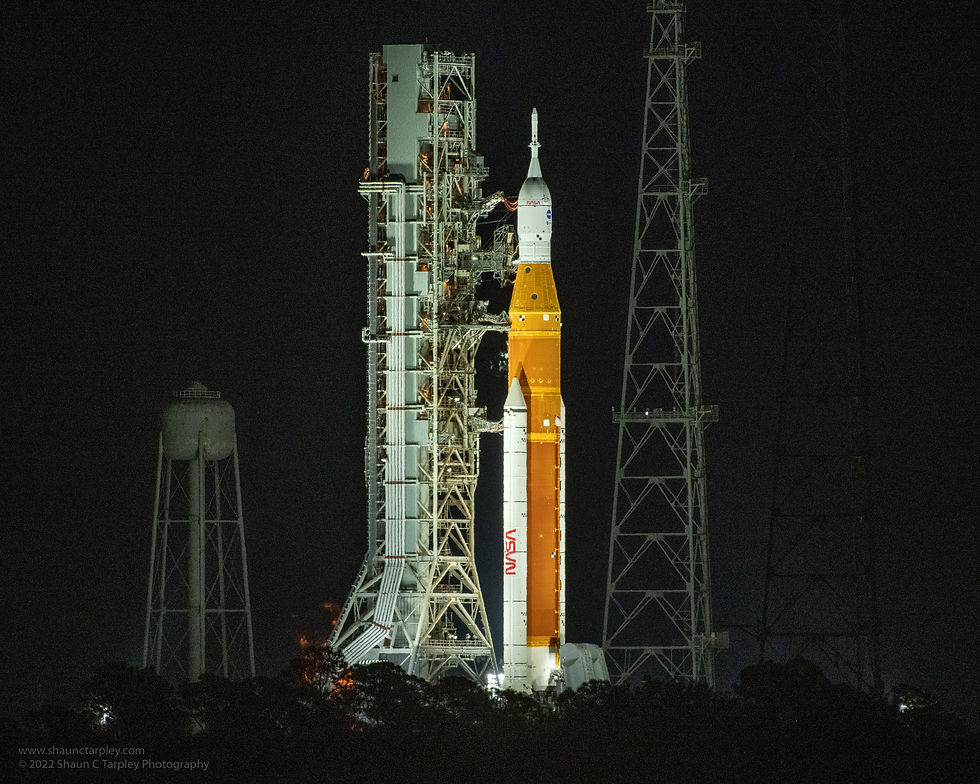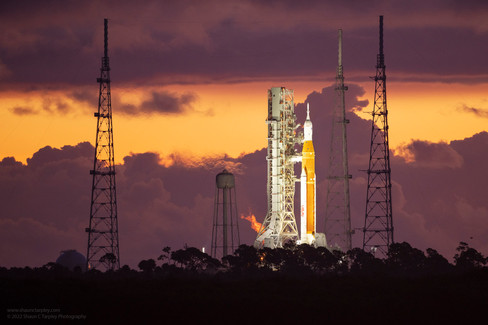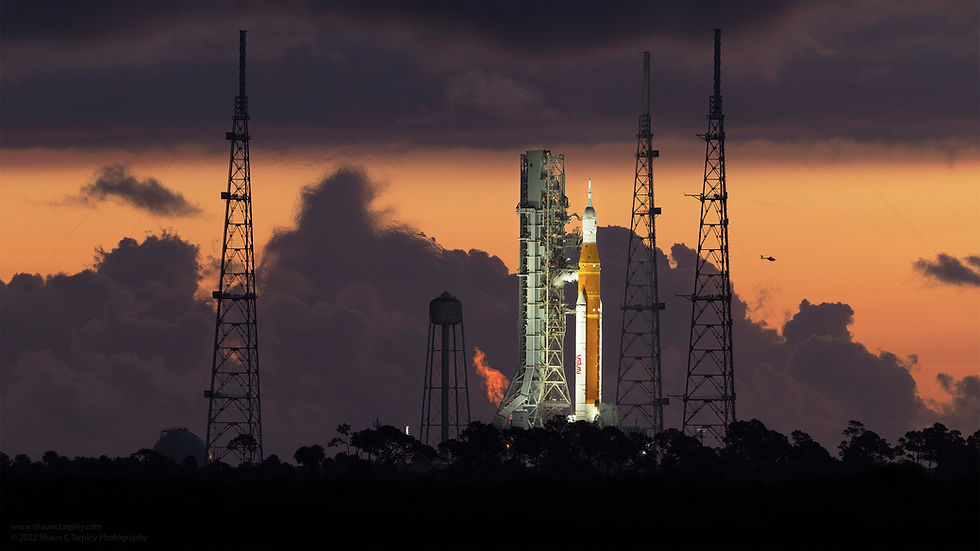Artemis 1.3 - To the Moon and Beyond
- Shaun C Tarpley

- Nov 30, 2022
- 9 min read
Updated: Dec 7, 2022
2022.11.16 - The first launch of any space rocket is difficult, but launching the largest, most powerful rocket in history in one shot is a herculean effort just from an engineering standpoint. However, once you add the unpredictable Florida weather to the mix, the achievement seems downright miraculous. After two attempts that were mired with bad weather and hydrogen leaks, a roll back due to hurricane Ian, and weathering hurricane Nicole on the pad, it was finally time for Artemis to pierce the heavens on its 1.3 million mile journey to beyond the Moon and back, and we were lucky enough to have a front row seat for the show.

Getting to Florida from Texas is a time-consuming and expensive endeavor, especially with a 4 year-old. My wife and I traveled to KSC for the first launch attempt, and we turned around and returned in 5 days for the second attempt with our son. However, after moving flights multiple times as potential launch windows closed due to repairs and weather delays, we began to wonder if we could manage a third trip in one year, especially with the holidays quickly approaching.
The chance to view a launch from Kennedy Space Center's Banana Creek Viewing Site is a rare and incredible opportunity. Due to my wife's tireless work on Artemis 1, she was awarded a seat at the closest public viewing site to Launch Pad 39b. She could have worked the mission from Mission Control, but instead she chose to experience the launch with us as a family. Given the rarity of the viewing opportunity, the historical nature of the first launch of SLS, and the closure that seeing the rocket launch would bring after years of work and sacrifice, we decided to schedule one last trip that ended up being a wild 48 hour round trip.
08/29/22 launch attempt 1 on the left, 09/03/22 launch attempt 2 on the right
While NASA worked towards a multitude of launch windows, Artemis made three full attempts to launch from the Cape. On the first early morning attempt, the weather was wild and unpredictable. The turbulent storms engendered an incredible sunrise, but unfortunately lightning strikes and hydrogen leaks would lead to a scrub.
On the second attempt just 5 days later, the launch window began at 1417. We arrived at sunrise so the hot, late summer sun beat down on us for hours as we waited on the metal bleachers. Our sleep-deprived 4 year-old had little patience for the early morning, hours of waiting, and oppressive heat. After about 4 hours, 3 hours prior to the launch window, the launch was scrubbed due to a hydrogen leak in the supply line connector that would take too long to repair before the launch window ended.
Multiple interim launch windows were passed over as the weather proved surprisingly volatile for so late in the hurricane season. Category 4 Hurricane Ian forced Artemis to take the long ride back to the VAB to avoid damage which scrubbed multiple launch windows. Artemis had only just made it back to the pad when Hurricane Ian arrived as only the third hurricane in history to hit Florida in November. NASA chose to ride out the Category 1 Hurricane which took the spacecraft to the very limits of what it had been designed to withstand.
The third attempt had a launch window starting at 0104. The late night weather was actually quite comfortable with a cool temperature and a light wind. Clouds and condensation were more of a concern, but it was nice to have a reprieve from hot and stormy weather. The launch team had learned a great deal from the first two attempts, so they started preparing SLS early in the afternoon on 11/15 to allow enough time for trouble-shooting.

In the middle of the night, staring off to the East over a lightless ocean, I was surprised at how dark the sky was given the site's proximity to Orlando. In the center of that dark mass of Earth and sky, a glowing beacon of white and orange towered stoically over the tree-dappled horizon, just waiting to be set free.
The remnants of an impressive dome of glittering stars crested overhead between ever-increasing cloud cover. Coincidently, the iconic Orion constellation (the namesake of Artemis' human-rated spacecraft) was easily visible to the Southeast (top right). Additionally, just above the launch pads, the orange glow of the red planet Mars was unmistakeable. The long term goal of the Artemis Program is to take what we learn from returning to the Moon and apply it towards a manned mission to Mars, so it was nice to see the future goal of Artemis glimmering above the pad. The Moon had technically risen by this point, but it had yet to crest the dense horizon of cloud cover, so unfortunately both goals couldn't be seen at the same time.

As the clouds built up behind SLS, the reflective glow around the rocket grew. It became increasingly evident that the clouds would play a role in this launch attempt, but how much of a role had yet to become evident.

The cloud cover became denser and denser as the night moved closer to the launch window. At around 2200, a hold was placed on the launch in order for NASA's Red Team to travel to the pad to tighten bolts on a hydrogen fuel valve that was leaking. As we waited through the hold, the Moon finally crested the wall of clouds guarding the horizon. Mars was no longer visible over the launch pad, but from my position, the Moon happened to land nearly equidistant between Launch Pads 39a and 39b, forming a shallow triangle of light that accentuated the juxtaposition between Artemis 1's terrestrial beginning and its rising celestial goal.

Launch Pad 39b (NASA) on the left, the Moon above, and Launch Pad 39a (SpaceX) on the right
By 2300, the Red Team returned from the pad after a successful repair. A few brief procedural holds came and went until we finally arrived at the official go/no go poll at KSC Mission Control around 0135. The poll was broadcast over the speakers at Banana Creek, so the crowd vibrated with excitement, anxiously cheering on each 'Go' verbalized by the front room. Before we knew it, Artemis was go for launch in T-10:00 minutes and counting. I rushed to my camera while my wife woke up our son. I'd never taken a photo of a rocket launch at night before, so I all my settings were based on educated guesses. The sudden rush of adrenaline made my body shake with anticipation. It was finally time for the launch we had been waiting so long and working so hard to see. Soon enough, Artemis would exceed my expectations in every way...including my camera settings.

I've seen a few Shuttle launches over the years, and I had certain expectations for SLS based on the similar SRB-based launch vehicle design. However, the power and sound of Artemis was far greater than what I remember with Shuttle. The rocket also left the pad with incredible acceleration, leaving the pad almost immediately after ignition.
I could sense that my exposure felt too high, so I made the mistake of trying to check the image on the rear screen instead of just dropping my shutter speed and trusting my instincts. However, the glow of the engines had momentarily night-blinded me, so when I tried to look at the dim screen on my camera, I couldn't see anything. I gave up on changing anything and just got back to shooting, but I was saddened to find that I had missed a lot in what seemed like only a second. At 500mm, things always move quickly.

Artemis began to roll clockwise (from the vantage point of future crew) and was almost immediately lost in low-lying cloud cover. The entire sky exploded with the brilliant, orange hue of the SRB's impressive plume of fire.

Artemis pitched away from us, heading slightly to the SE from our vantage point. The dense clouds all but shrouded the capsule in haze, but the details of the lower half glowed in the heat of the propellant trailing behind it.

Well beyond the reach of my 500mm lens, at approximately 2 minutes and 12 seconds into the flight, the SRBs flanking the core stage of Artemis completed their work and separated from the Core Stage in a blast from the Booster Separation Motors. In hindsight, I had the time to swap in my 1.4x teleconverter to get a higher definition image of the event, but as the rocket reached the long-end of my lens' reach, I honestly just took a minute to stand back enjoy the experience beyond my camera. It may have cost me a higher resolution image of booster separation, but I honestly don't regret it.

Booster separation from initialization on the left, to full separation to the far right
From our perspective, Artemis passed to the left of the moon by roughly 3 to 4 degrees. Parallax has more of an influence on these type of shots than you might think. For someone located well North of our position, Artemis's path could have appeared much closer to the Moon.
The path of a rocket is inherently difficult to discern from the perspective of a human on Earth. From our vantage point, SLS arced high into sky before seemingly falling towards the horizon, but in fact it was ascending higher and farther away from us. After reaching orbit around the Earth, the top stage of the rocket conducted a Trans-Lunar Injection (TLI) burn of the Interim Cryogenic Propulsion Stage (ICPS) which accelerated the Orion Spacecraft into a trajectory that would lead it 239,000 miles to the Moon. Subsequent burns closer to the Moon will put Orion on its distant retrograde orbit 40,000 miles beyond the Moon, and then on its return trajectory back to Earth over a 25-day, 1.3 million mile mission to test every aspect of the SLS system that will support a crew during Artemis 2.

Roughly the size and brightness of a star, Artemis passed to the left of the moon on its path into orbit
I set up my Nikon D750 on a separate tripod next to the telephoto rig with the 20mm f1.8 looking over the water. The plan was to take a wide-angle shot of the launch path of the rocket. I did a few test shots earlier in the evening to verify the total exposure on the surrounding environment, and had settled on a 4 minute exposure that would incapsulate a large portion of the glowing arc of the rocket beyond the pad. However, I failed to anticipate how incredibly bright Artemis would be, especially so close to the pad. Needless to say, the launch completely overexposed my image and the resulting data was unrecoverable, so all I have is a subsequent wide-angle shot of Artemis as it disappeared into space along the horizon. In the future, I will need to stop down the exposure considerably to get this kind of shot at this proximity to the rocket.

Before we knew it, countless hours of work and sacrifice had culminated in the explosive first step of the mission. However, weeks of work were only just beginning as NASA's teams started executing each subsequent phase of its mission to fly beyond the Moon and return to Earth safely. For now though, the launch was over and it was time to refocus. With the adrenaline of the evening slowly fading, and exhaustion quickly setting in, we quickly packed our belongings, tossed a tired kid over our shoulder, and weaved through a maze of buses to find an open seat.
Our son had enjoyed the launch, but he complained about how bright and loud it was. I'm not sure when or if the incredible importance of the moment will sink in. Perhaps it won't be until he looks back on this day much later in life. Regardless, it was amazing for his Mom and me to experience this historic and surprisingly personal moment with him as a family, and we can only hope it will mean as much to him someday.
As the fading plume of smoke drifted into the night air, it briefly passed in front of the waning gibbous Moon. I stared at the Moon for a long while that night, contemplating the arrival of the Orion Spacecraft and the ensuing manned-missions that will soon return to its orbit and surface. It has taken 50 years, but we are finally going back. Selenophiles rejoice!

The trip as a whole had been a grueling endeavor. We woke up at 0300 CST in Houston on the 15th, flew to Tampa, drove 3 hours to Merritt Island, and arrived with only enough time to nap for a few hours with a crazy child. From there, we drove to catch a bus to KSC, watched Artemis 1 launch at 0147 EST, and got back to our lodging by 0400. I worked on photos and posts until after 0600, slept for a few hours, and then packed up to drive back to Tampa by 1930 to catch our flight back to Houston at 2100. Just before the 48 hour mark, we were back at home around 0100 CST and wouldn't get to sleep until around 0300. I can't say that I would ever willingly take another trip like that, but it was well worth it for this historic experience.
Until we meet again Artemis/Orion, say hello to the Moon for us.
© 2017-2022 Shaun C Tarpley









Comments